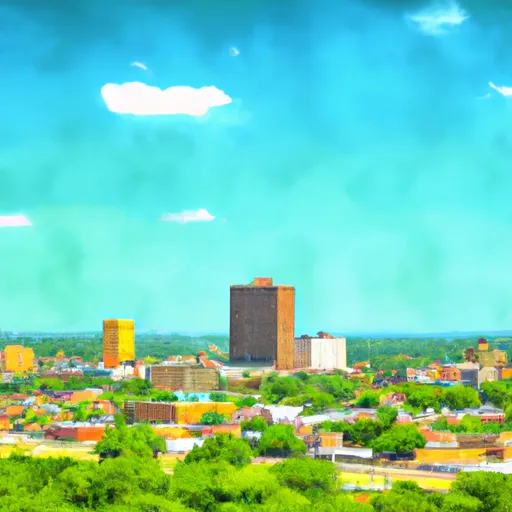-
 Snoflo Premium
Snoflo Premium
Get unlimited access to all our content
With no Ad interruptions! - Start Your Free Trial Login with existing account
Whiteface
Eden Index
Climate
9.2
•
Recreation
1.1
•
Community
0.7
•
Safeguard
4.2/10

Whiteface, Texas is a small town located in Cochran County in the western part of the state. It is characterized by a dry and arid climate with hot summers and mild winters. The average high temperature in summer is around 93°F (34°C) while winter temperatures average around 57°F (14°C). Precipitation is relatively low, with an annual average of about 16 inches (41 cm), mostly occurring during the summer months.
Regarding hydrology constituents, Whiteface is not situated near any major rivers or lakes. Its water supply mainly comes from underground aquifers, with the Ogallala Aquifer being the most significant. This aquifer provides water for irrigation and domestic use in the surrounding agricultural areas.
Despite its arid climate, Whiteface offers several outdoor recreation opportunities. The town is surrounded by vast open spaces and farmland, making it ideal for hiking, bird watching, and nature photography. Nearby White River Lake State Park provides opportunities for fishing, boating, and camping. The park is known for its scenic beauty, with rolling hills and a picturesque lake, attracting outdoor enthusiasts seeking relaxation and tranquility. With its unique climate and natural beauty, Whiteface, Texas offers a variety of outdoor activities for nature lovers and those seeking a break from city life. Overall, it is a charming destination for outdoor recreation.
What is the Eden Index?
The Snoflo Eden Index serves as a comprehensive rating system for regions, evaluating their desirability through a holistic assessment of climate health, outdoor recreation opportunities, and natural disaster risk, acknowledging the profound impact of these factors on livability and well-being.
Climate Health Indicator (CHI): 9.2
Whiteface receives approximately
451mm of rain per year,
with humidity levels near 75%
and air temperatures averaging around
15°C.
Whiteface has a plant hardyness factor of
7, meaning
plants and agriculture in this region tend to thrive during the non-winter months.
By considering the ideal temperature range, reliable water supplies, clean air, and stable seasonal rain or snowpacks, the Climate Health Indicator (CHI) underscores the significance of a healthy climate as the foundation for quality living.
A healthy climate is paramount for ensuring a high quality of life and livability in a region, fostering both physical well-being and environmental harmony. This can be characterized by ideal temperatures, reliable access to water supplies, clean air, and consistent seasonal rain or snowpacks.
Weather Forecast
Streamflow Conditions
Brazos Headwaters
Area Rivers
Brazos Headwaters
Snowpack Depths
Brazos Headwaters
Reservoir Storage Capacity
Brazos Headwaters
Groundwater Levels
Recreational Opportunity Index (ROI): 1.1
The Recreational Opportunity Index (ROI) recognizes the value of outdoor recreational options, such as parks, hiking trails, camping sites, and fishing spots, while acknowledging that climate plays a pivotal role in ensuring the comfort and consistency of these experiences.
Access to outdoor recreational opportunities, encompassing activities such as parks, hiking, camping, and fishing, is crucial for overall well-being, and the climate plays a pivotal role in enabling and enhancing these experiences, ensuring that individuals can engage in nature-based activities comfortably and consistently.
Camping Areas
| Campground | Campsites | Reservations | Toilets | Showers | Elevation |
|---|---|---|---|---|---|
| Chamber of Commerce RV Park - Seagraves | 5 | 3,346 ft | |||
| Yoakum County Park | 16 | 3,604 ft | |||
| Gaines County Park | 18 | 3,324 ft | |||
| Seminole City Park | 10 | 3,311 ft |
Nearby Ski Areas
Catastrophe Safeguard Index (CSI):
The Catastrophe Safeguard Index (CSI) recognizes that natural disaster risk, encompassing floods, fires, hurricanes, and tornadoes, can drastically affect safety and the overall appeal of an area.
The level of natural disaster risk in a region significantly affects safety and the overall livability, with climate change amplifying these risks by potentially increasing the frequency and intensity of events like floods, fires, hurricanes, and tornadoes, thereby posing substantial challenges to community resilience and well-being.
Community Resilience Indicator (CRI): 0.7
The Community Resilience Indicator (CRI) recognizes that education, healthcare, and socioeconomics are crucial to the well-being of a region. The CRI acknowledges the profound impact of these elements on residents' overall quality of life. By evaluating educational resources, healthcare accessibility, and economic inclusivity, the index captures the essential aspects that contribute to a thriving community, fostering resident satisfaction, equity, and social cohesion.

